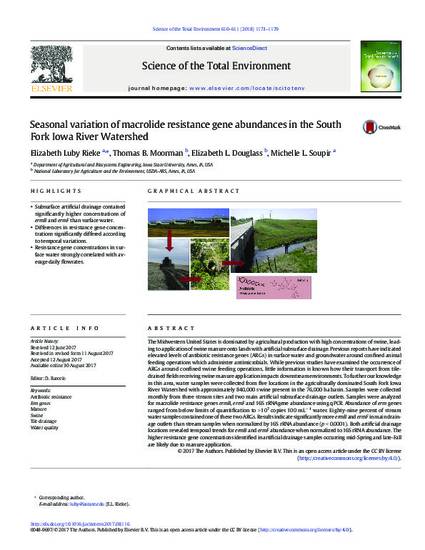
The Midwestern United States is dominated by agricultural production with high concentrations of swine, leading to application of swine manure onto lands with artificial subsurface drainage. Previous reports have indicated elevated levels of antibiotic resistance genes (ARGs) in surface water and groundwater around confined animal feeding operations which administer antimicrobials. While previous studies have examined the occurrence of ARGs around confined swine feeding operations, little information is known how their transport from tile-drained fields receiving swine manure application impacts downstream environments. To further our knowledge in this area, water samples were collected from five locations in the agriculturally dominated South Fork Iowa River Watershed with approximately 840,000 swine present in the 76,000 ha basin. Samples were collected monthly from three stream sites and two main artificial subsurface drainage outlets. Samples were analyzed for macrolide resistance genes ermB, ermF and 16S rRNAgene abundance using qPCR. Abundance of erm genes ranged from below limits of quantification to > 107 copies 100 mL− 1 water. Eighty-nine percent of stream water samples contained one of these two ARGs. Results indicate significantly more ermB and ermF in main drainage outlets than stream samples when normalized by 16S rRNA abundance (p < 0.0001). Both artificial drainage locations revealed temporal trends for ermB and ermF abundance when normalized to 16S rRNA abundance. The higher resistance gene concentrations identified in artificial drainage samples occurring mid-Spring and late-Fall are likely due to manure application.
Available at: http://works.bepress.com/michelle_soupir/57/

This article is published as Rieke, E.L., T.B. Moorman, E.L. Douglass and M.L. Soupir. 2018. Seasional variation of macrolide resistance gene abundances in the South Fork Iowa River Watershed. Science of the Total Environment 610-611: 1173–1179, doi:10.1016/j.scitotenv.2017.08.116. Published with permission.